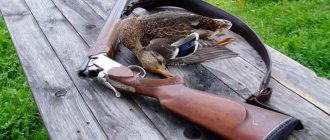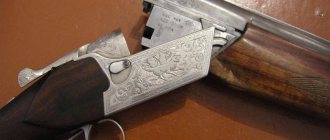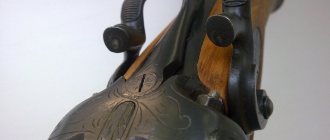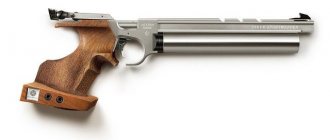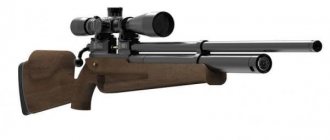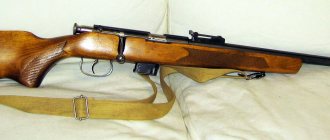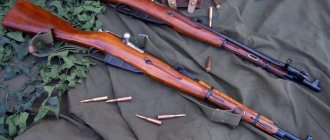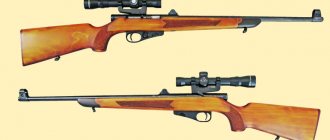TOZ-8 is a Soviet single-shot small-caliber rifle of 5.6 mm caliber (or .22 LR). Produced since 1932 at the Tula Arms Plant. The TOZ-8 rifle is distinguished by its simple design, trouble-free operation and high reliability. For many years it was used for initial shooting training in school shooting ranges and DOSAAF. In our time, it is still used by hunters in the Urals, Siberia and the Far East for hunting small game. Some structural elements of the TOZ-8 rifle are used in the designs of modern training and training rifles.
History of the creation of TOZ-8
The TOZ-8 rifle was created in 1932 at the Tula Arms Factory by the talented designer Dmitry Ivanovich Kochetov.
The predecessor of the TOZ-8 rifle was the TOZ-7 rifle, which was put into mass production in 1928, after some time it was modernized and received the designation TOZ-7A. The TOZ-8 rifle was created on the basis of the TOZ-7A rifle. In 1931, tests took place in Moscow for which rifles designed by D.I. Kochetov, A.A. were presented. Smirnsky and S.A. Korovina. Based on the results of these tests, the rifle designed by D.I. Kochetov was recognized as the best, which was put into mass production under the name TOZ-8.
The TOZ-8 single-shot small-caliber rifle immediately began to be supplied to OSOAVIAKHIM, and then to DOSAAF. Millions of Soviet people were trained to shoot from the TOZ-8 rifle.
The TOZ-8 rifle was produced without changes in design until the Great Patriotic War, after which production of a modernized version of the rifle began, called TOZ-8M. Based on the TOZ-8 single-shot rifle, a repeating rifle was created under the designation TOZ-9.
During the Great Patriotic War, the TOZ-8 single-shot rifle and the TOZ-9 multi-shot rifle were used by Soviet partisan formations.
Nowadays, the TOZ-8 small-caliber rifle is used by some hunters for hunting small game. The TOZ-8 rifle is especially common in the Urals and Siberia.
Small caliber, big benefit
And with a history of more than a century and a half, side-ignition cartridges occupy the niche of ammunition for sports and training purposes. The cheapness of such cartridges attracted the attention of Soviet specialists back in the 20s, allowing them to build an entire system of initial training of shooters using small-caliber weapons.
Small caliber pioneers
One of the founders of Soviet shooting sports A.A. In the 20-30s, Smirsky was the first to develop several models of small-caliber weapons based on standard combat samples. In 1925, the first was the Model 1 small-caliber rifle, which was an 1891 model rifle with minimal changes, converted to fire a 5.6 mm cartridge. During the conversion, a new barrel was installed on the rifle, the magazine box was removed, the combat face, the ejector, the firing pin and sighting devices were changed. This version of the training weapon did not last long and was replaced by the more advanced “model 2”, which was structurally different from its combat prototype.
Smirnsky small-caliber rifle (model 1) TGMO
This was followed by modifications to the 1895 model revolver (Nagan-Smirnsky) and the 1933 model TT pistol (products R-3 and R-4 designed by G.V. Sevryugin). After the war, the era of Margolin sporting pistols began with the now classic target MC, which gave rise to a whole family of small-caliber pistols (MTsU, MTsM, MTsMK). Despite the fact that in design terms such products were no longer directly related to military weapons, the MCM pistol under the symbol 56-A-111 was adopted by army units, and its cartridge had the index 57-N-811.
Of the variety of side-fire (rimfire) cartridges, only 5.6 mm caliber variants were in demand half a century later: .22 Long Rifle (.22LR) with a long sleeve (15 mm) and .22 Short with a short sleeve (10.5 mm) . The former are used not only in small-caliber rifles, but also in pistols, while the latter are much less common (exclusively in short-barreled weapons). In the same 20s, Soviet industry mastered the production of such cartridges from scratch for its needs. Over time, for high-precision shooting from “small guns”, special cartridges with improved precision combat characteristics (PTB), target, “Extra”, “Sniper” and some others began to be produced.
Modern rifle small-caliber rimfire cartridges TsNIITOCHMASH
Bloom system
The main “Stakhanovite” in the field of saving ammunition can be considered M.N. Blum, who proposed a whole system of training weapons for the most expensive class of weapons - machine guns. At the very end of the 20s, Blum proposed his system of training firing from heavy machine guns of the 1910 model of the Maxim system. The 56-P-851 small-caliber machine gun was a simplified weapon design with a barrel, receiver, return spring, trigger mechanism and magazine. The structure weighed just over 3 kg, excluding the one-kilogram empty magazine, and was placed at different times inside, on top or on the side of the combat machine gun. Such small-caliber training weapons made it possible to fire both single shots and bursts in shooting ranges ranging from 25 to 100 m in length.
Shooting from small-caliber machine guns of the Blum system forum.guns.ru
Subsequently, similar versions of small-caliber tank, aircraft and light machine guns appeared. They differed mainly in the method of attachment and the options for its placement on the combat model. Blum machine guns could be placed on training weapons or even mock-ups. One of the features of such weapons was a drum magazine, in which the spent cartridge returned after being fired into its socket. An attempt was made to introduce into service a small-caliber carbine-machine gun, which was a submachine gun with a barrel 400 mm long.
According to Blum's research, the production of one 5.6 mm side-fire cartridge, in comparison with a 7.62 mm rifle cartridge, consumes 40 times less gunpowder, 25 times less case metal, and 4 times less bullet lead. By multiplying these figures in terms of millions of cartridges, anyone can estimate the scale of the cost savings. Also, such cartridges do not use a non-flammable primer for ignition, which has a positive effect on the operation and preservation of the weapon.
Tula "eight"
In the early 30s, designer D.M. Kochetov developed a successful design for a small-caliber rifle, which began to be produced at the Tula Arms Plant (TOZ) under the designation TOZ-8. It was the TOZ-8 that for many years in the USSR became an army training weapon for marksmen and the first tool of a novice sniper. In addition to the positive economic effect when using ammunition, such weapons had a high guaranteed barrel life, which is no less important for intensive shooting training. For various TOZ-8 models, it ranges from 12,000 to 14,000 rounds, which, compared to the SVD’s survivability of 6,000 rounds, gives a twofold advantage.
TOZ-8-01 rifle, modified today reibert.info
Using previous experience in the design and operation of small-caliber rifles, Kochetov improved the design of the bolt, maintaining the previously existing technology for manufacturing the barrel, receiver and stock. The front part of the bolt was cut to half, and grooves were made on both sides in which the ejector and cartridge holder were placed. The reduced dimensions made it possible to cover the rear part of the receiver with a lid that protected from powder gases formed when the cartridges ruptured due to the unsatisfactory quality of the cartridges of that time. An insert was also introduced, which made it possible, if necessary, to make repeating rifles with minor alterations based on this sample.
An interesting parameter of weapons chambered for small-caliber cartridges is the effective firing range. Thus, the instructions indicate that the maximum flight range of a .22LR cartridge bullet is no less than 1200-1600 m, while maintaining its destructive power at a distance of 800 m. Perhaps such data may seem overestimated given the TOZ-8’s target range of only 250 m. Moreover, each new model of a small-caliber rifle with a constant barrel length lost these most treasured meters over time. Thus, the target range of the TOZ-8M was already 200 m, while that of the TOZ-8-01 and TOZ-12 was only 100 m. It is the figure of 100 m that today is considered the maximum effective firing range from such small-caliber rifles.
Use of TOZ-8 in training marksmen of internal troops mvd.gov.by
In addition to the military past of the family of Tula rifles designed by Kochetov, there is information about the use in law enforcement agencies of other small-caliber rifles, such as SM-2 with a diopter sight or TOZ-18 with optical sights PO 2.5 × 20 or PO-1M.
Sniper "small"
The first experience of creating a special training sniper rifle (TSV) in 1969-1971 at Izhmash remained unclaimed. Then the designers A.N. Voznesensky and V.F. Susloparov under the leadership of E.F. Dragunov proactively offered the military a TSV-1 rifle based on the SVD. A barrel with sighting devices, a bolt with a return mechanism and a trigger mechanism were attached to the aluminum alloy receiver in separate blocks. The magazine with a capacity of 10 rounds was compatible with the magazine of Margolin MC pistols. The receiver had a side rail for attaching sights, including PSO-1.
TSV-1 rifle, 1971 kalashnikov.media
The TSV-1 rifle was tested at the TsNIITOCHMASH training ground and the Vystrel courses. However, then the commission’s conclusion stated that “the use of a small-caliber rifle for training snipers does not solve the entire range of training tasks.”
. Once again the option of developing a training sniper rifle at Izhmash was returned in 1989, when V.Yu. Simonenko developed a sample with maximum use of parts from SVD. The leadership of DOSAAF showed interest in this product, but the beginning of the 90s put an end to this development.
Another interest in a small-caliber rifle with increased accuracy in the late 90s arose among representatives of the law enforcement agencies of the Russian Federation themselves. The SV-99 sniper rifle was developed for the needs of FSB snipers, who had the need to use such weapons in urban environments in limited spaces to perform some specific tasks (for example, disabling lighting fixtures). The basis of the small sniper rifle was the Bi-7-2 rifle and the Sobol carbine. The biathlon past of the new rifle left it with a quick reloading system, when the bolt handle is moved by the shooter only with a straight backward movement.
An early version of the SV-99 rifle with a PO4×34 sight. "Weapons" magazine
The design of the SV-99 took place under the leadership of V.F. Susloparov, who at Izhmash had extensive experience working with weapons chambered for rimfire. The Izhevsk rifle is equipped with a collapsible stock, from which the butt is separated. This allows you to put the entire set of the rifle in a small case for hidden transportation, and instead of a stock, attach a pistol grip, getting a compact sniper tool. The customer has the option of a rifle with a wooden or plastic stock, as well as with a right- or left-hand bolt handle.
Rifles SV-99.Sb0 and SV-99.Sb0-02 with a PO 3.5×17.5P sight kalashnikovconcern.ru
The rifle was adopted by the FSB in 2004, and by the Ministry of Internal Affairs and Internal Troops in 2005 and 2007, respectively. In all cases, the small-caliber SV-99 walked side by side with its “big sister” SV-98 of normal caliber. Thus, we can conclude that most law enforcement agencies have adopted a full-fledged sniper complex as part of combat and training sniper rifles developed by Izhevsk designers.
Rifles SV-98 and SV-99 Mikhin M.
At the same time, as often happens with military weapons developed on the basis of sporting or hunting models, it has its own civilian version.
In 2016, the Bi-7-2-KO hunting carbine was presented to the general public. 11, which has a stock that is as similar as possible to the combat version of the weapon and is also interchangeable with standard versions. Of course, hunters will not be able to equip them with a silencer and a collapsible stock, but fans of the military style will be able to satisfy their needs. Rifle characteristics
| Name | 56-P-851 | TOZ-8 | TOZ-12 | SM-2 | TSV-1 | SV-99 |
| Weight, kg | 3,3 | 3,12 | 3-4 | 5 | 4,2 | 3,75 / 4,5 |
| Magazine capacity, cartridges | 39 | – | – | – | 10 | 5 / 10 |
| Length, mm | 946 | 1113 | 1020-1110 | 1118 | 1070 | 720 / 1030 |
| Barrel length, mm | 645 | 640 | 600-640 | 680 | 300 | 350 |
| Sighting range, m | 200-300 | 250 | 100 | 100 | n/a | 100 |
Sources and literature:
- 5.6 mm small-caliber machine guns of the Blum system. Description. Voenizdat. - M., 1937
- Blum M. N. Small-caliber machine guns. Edited by the Central Committee of Osoaviakhim of the USSR. - M., 1940
- Yurchuk S. P., Konoplev M. A. Material part of Soviet sports weapons. DOSAAF. - M., 1966
- Sniper rifle SV-99. Operating manual SV-99RE
Characteristics of TOZ-8
- Rifle weight:
3120 grams - Overall rifle length:
1110 mm - Barrel length:
640 mm - Rifle caliber:
5.6 mm - Number of grooves:
4 - Rifling pitch:
350 mm - Initial bullet speed:
280-350 m/s - Sighting range:
250 meters - Distance to maintain the lethal force of a bullet:
800 meters - Maximum bullet range:
1200-1600 meters - Operating principles :
sliding bolt
Hunter reviews
Despite the fact that the TOZ-12 carbine is intended for sports and training shooting, the model is also in great demand among professional hunters and amateurs. You can find out exactly why the rifle was loved, as well as what shortcomings it has, from the reviews.
Firstly, many hunters note that the TOZ-12 carbine is almost the most reliable and trouble-free small thing from TOZ. The modification with an extractor can be safely used even by Siberians, and the standard model will serve the owner for 5-6 years or until he fires 5,000 shots from it. Repairing the rifle and replacing spare parts is also not particularly difficult, making the model perfect for novice hunters.
Secondly, some hunters also share their impressions of how exactly the weapon behaves during hunting. For example, TOZ-12 does not lack power, so you can hunt both quail and adult fox with it. The most important thing is to choose the optimal ammunition. In this regard, it would be best to stick with hollow-point or standard pointed bullets with a steel or brass tip.
Thirdly, hunters also do not forget to mention the shortcomings of the rifle. The most famous of these is that the firing pin misfires from time to time. This scenario is especially often repeated after lubricating the weapon - the oil thickens and prevents the mechanism from making an accurate hit on the primer. To prevent this from happening, it is best to carry out maintenance of the trigger frequently, but in moderation. Excessive amounts of lubricating fluid will only harm the rifle.
Thus, TOZ-12 is a good choice for a modern hunter, even though more than half a century has passed since the rifle was released, and it was intended for sport. First of all, the weapon will appeal to those who like to modify carbines. The model will also appeal to fans of hunting with a small-caliber rifle, because despite the fact that it uses 5.6 mm cartridges, the penetration power of the TOZ-12 remains high.
Modifications
- TOZ-8
is the basic model of the rifle, produced from 1932 until the end of the Great Patriotic War - TOZ-8M
is a modified version of the rifle, production began after the end of the Great Patriotic War. Unlike the basic modification of the rifle, the TOZ-8M rifle has a sector-type sight, which allows it to be adjusted in height. The front sight is equipped with a ring earpiece. The bolt of the TOZ-8M rifle has a smaller diameter bolt and does not have a clutch, making the rifle more convenient to reload. The rifle stock has a wider fore-end. - TOZ-9
is a magazine version of the rifle, developed in 1933 by designer D.I. Kochetov based on the TOZ-8 rifle. The TOZ-9 rifle has a box magazine that holds 4 cartridges, the fifth cartridge is in the chamber. The magazine is located inside the rifle stock, is inserted from below and is secured against falling out with a latch. - TOZ-11
is a lightweight version of the rifle developed in 1946 by designer K.I. Shikhvatov especially for commercial hunters. Produced from 1946 to 1957. Rifle weight 2 kg. The rifle had a new birch stock. - TOZ-12
rifle model was developed by designer D.M. Kochetov based on the TOZ-8 rifle. - TOZ-16
is a rifle created on the basis of the TOZ-8M rifle, taking into account the experience gained in the production and use of the TOZ-11 rifle. Many parts of the rifle are borrowed from the TOZ-8M rifle.
In order to find out the year of manufacture of the TOZ-8 rifle, just look at the stamp on the barrel box; before 1986, the year of manufacture of the rifle was indicated by a letter code, and after 1986, by two numbers in front of the serial number of the rifle.
Trunk
The TOZ-8 rifle has a cylindrical barrel of great thickness, the length of the rifle barrel is 640 mm. There are four screw grooves inside the barrel. The rifling pitch is 350 mm.
In the front part of the barrel there is a longitudinal groove into which the base of the front sight is installed. There are two longitudinal grooves in the rear part of the barrel; they are used for attaching the sighting block. At the back of the barrel there is also a special stump to which the receiver is attached using a pin.
Receiver
The receiver of the TOZ-8 rifle looks like a simple pipe, which looks like an extension of the barrel. Inside the receiver there is a bolt, the receiver also serves as the basis for the firing mechanism. A wooden stock is attached to the bottom of the receiver.
On the right side of the receiver there is a shaped cutout along which the bolt handle guide moves.
On the right side of the receiver, in front of the figured cutout, there is a window that is needed for inserting a cartridge and ejecting spent cartridges. Two holes were drilled next to it, designed to remove escaped powder gases.
At the rear of the receiver there is a special removable cap that performs three important functions:
- The cap closes the receiver channel and thereby protects it from contamination
- The installed cap eliminates the possibility of the shutter falling out
- The cap protects the shooter's eye in the event of a breakthrough of powder gases into the receiver channel.
At the bottom of the receiver there is a pyramidal stop designed to secure the barrel and receiver with a wooden stock.
Inside the receiver there is a liner that is secured with a screw. The insert guides the cartridge into the rifle's chamber when loading, deflects the spent cartridge case when ejecting, and guides the bolt when moving forward.
Gate
A longitudinally sliding rotary bolt moving inside the receiver is needed to send a cartridge into the chamber, lock the barrel, fire a shot and eject the spent cartridge case from the chamber.
The bolt of the TOZ-8 rifle consists of a combat cylinder, a bolt stem with a handle, a trigger, a firing pin with a striker, a mainspring and a coupling.
Combat cylinder - designed to connect all parts of the bolt into a single whole. Inside the combat cylinder there is a channel in which the firing pin and the mainspring are located. The combat larva has a special cup for placing the cartridge cap. On the right and left of the combat cylinder there are grooves for the ejector and sleeve deflector. In the front part of the combat cylinder there is a protrusion that serves as a cartridge rammer. In the rear part of the combat cylinder there is a stump with a hole for putting on the bolt stem with a handle.
The bolt stem with a handle is necessary for ease of operation of the bolt. Has two small and two large cutouts.
Ejector - used to remove the spent cartridge case from the chamber and throw it through the window in the receiver.
The sleeve deflector is intended to fix the cartridge in the cup of the bolt cylinder.
The firing pin is needed to strike the cartridge case to fire a shot. A mainspring with a coupling is put on the firing pin.
Trigger - necessary to keep the firing pin cocked. There is a hole inside the trigger for screwing onto the firing pin, which is additionally secured with a pin.
The TOZ-8 rifle does not have lug lugs; the bolt is locked using the loading handle.
Trigger mechanism
The impact mechanism of the TOZ-8 rifle consists of the following parts:
- Trigger - performs the function of setting the striker to cocking. It is screwed onto the back of the firing pin and secured with a pin.
- The firing pin is used to strike the cartridge case with the firing pin, which leads to a shot.
- The mainspring—expanding at the moment of firing, strikes the cartridge case with the firing pin.
- Coupling - connects the firing pin to the combat cylinder.
All parts of the firing mechanism are located inside the rifle bolt.
The trigger mechanism of the TOZ-8 rifle is designed for decocking; it consists of the following parts:
Trigger - when the trigger is pressed, the hammer is released from the cocking position, which, together with the firing pin, moves forward, pricks the rim of the cartridge case, and a shot occurs. The trigger is connected to the trigger spring using an axle. There are two protrusions on the trigger, due to which the trigger spring is pulled down.
Trigger spring - ensures that the trigger is cocked. The trigger is secured at the bottom of the rear of the trigger spring. The front end of the trigger spring is secured with a screw to the receiver. In the upper part there are two cuts, one for fixing the hammer on cocking, the second for limiting the movement of the bolt back.
The trigger mechanism is mounted at the bottom of the receiver.
The trigger is protected from accidental pressing by a trigger guard, which is attached to the fore-end with two screws.
Bullets
This model, according to many, is not only convenient and easy to use, but also has excellent shooting accuracy and adaptability. The new modification, which has one trigger with a selector, makes it possible to instantly fire two shots in a row, and this is sometimes very necessary when hunting. This gun is cocked when it is opened: when it returns to its original state, the weapon is ready to fire. A very convenient solution is the extension of sleeves, carried out due to the “activity” of separate ejectors. Many users especially like the fact that the spent cartridge case is immediately and automatically ejected by the ejector.
The lever on the selector for the sequence of shots is also a fuse. A specially designed modification of the TOZ-120 with a 76 mm chamber allows firing with a Magnum-type bullet.
Aim
The sights of the TOZ-8 rifle consist of a front sight and an open sector sight.
The front sight is cylindrical and has a long base. The TOZ-8M modification rifle has a round muzzle guard.
The sector sight consists of an aiming block, an aiming bar, a clamp and a spring.
- The sighting block is used to attach the sighting bar, pin and spring.
- The sighting bar has ten notches, designed for firing distances from 25 to 250 meters. The aiming bar has a mane with a slot through which aiming is carried out. The side edges of the sighting bar have cutouts for attaching a clamp.
- The clamp serves to fix the aiming bar in a certain position. When the clamp moves along the aiming bar, the angle of the aiming line changes depending on the distance to the target.
- The sighting bar spring secures the bar from movement.
- The TOZ-8 rifle can be equipped with an optical sight. The optical sight is mounted on the left side of the receiver on a special adapter strip. When using an optical sight, the rifle provides increased combat accuracy.
Pros and cons of TOZ-34
Like any weapon, TOZ-34 has both its positive and negative sides.
Advantages
"Vertical" guns are more convenient for a quick repeat shot - both barrels are on the same line of sight
Light weight, which is useful when shooting offhand - for example, at a bird on the rise
Internal hammers reduce the time it takes to reload a weapon - when the barrel is returned to its place, the hammers are already cocked
Accuracy and balance of the gun, which will be a good indicator for inexperienced shooters
Possibility of choosing a barrel (in case of loading with different cartridges)
Flaws
TOZ-34 does not tolerate frequent use of powerful ammunition - the barrel locking mechanism is not very reliable, and the hinge mechanism can also fail due to them
High accuracy can also be attributed to disadvantages - for example, it is difficult to hit several targets in a flock with shot
Far from acceptable pellet shedding at firing distances reduces the chances of successfully hitting the target when fire is fired at distances over thirty meters
A fatal drawback is the idle pull of the triggers, which increases the firing time
As you noticed, the gun has more advantages than disadvantages. Moreover, I did not list the minor amenities and inconveniences of the gun.
TOZ-8 rifle stock
The TOZ-8 rifle had a stock made of birch. The stock has a butt, a pistol-type neck and a thickened wide fore-end.
The barrel and receiver are attached to the stock using a thrust screw and a screw that is screwed into the receiver shank.
For ease of carrying the rifle, there are two swivels on the stock. On the back side of the butt there is a metal butt plate secured with two screws.
There is a safety guard at the bottom of the stock that protects the trigger from accidental pressing. The safety bracket is attached to the stock with two screws.
General description of the TOZ-34 12 gauge shotgun
Structurally, the “thirty-four” is a double-barreled shotgun with a vertical barrel arrangement, hammerless type, with the now traditionally different diameters of the barrels - the upper one is shaped like a choke (smooth conical narrowing of the barrel), and the lower one is shaped like a choke (also a conical barrel, but with a reduced narrowing). This barrel bore structure ensures shot accuracy comparable to that of more expensive imported shotguns from Bernardelli, Beretta or Browning.
Both hidden hammers are cocked at the moment of “breaking” the gun for reloading, which has a positive effect on the rate of fire - an experienced shooter will only need about ten seconds to reload the TOZ-34, along with the extraction of cartridges. In the “breaking” scheme of the gun, the designer, soon after the start of mass production, abandoned the outdated scheme with squeezing the trigger, replacing it with a lock with a flag lock - this saved the TOZ-34 from the problem of sudden breaking of the gun, which every owner of a double-barreled gun has encountered at least once in his life guns.
Each barrel has its own trigger, which allows you to select the cartridge required for the shot (there are “exotic” shooters who prefer to load the gun with two types of cartridges). There is one common safety for both triggers, located behind the barrel break lever. The barrel itself has different thicknesses - the thickest part is located in the breech (the area with the highest pressure), then thins to approximately the middle of the barrel, and then towards the muzzle, thickens again - this is done to reduce the vibration of the barrel when fired.
The handle and butt of double-barreled shotguns are traditionally made of solid wood, usually birch or beech, but in piece models they also use solid walnut.
The forend is made of the same material as the butt with the handle, and is rigidly attached to the barrels and cannot be removed without a special tool.
Operating principle
The TOZ-8 rifle is single-shot, it does not have a magazine, and you can only load it one cartridge at a time manually by inserting the cartridge into the opening in the receiver.
For firing from the TOZ-8 rifle, small-caliber rimfire cartridges are used; they do not have a separate primer for igniting the powder charge; the ignition charge is pressed into the bottom of the cartridge case. The cartridge case is 16 mm long, made of brass, and has a protruding lip at the bottom of the cartridge case. The cartridge is loaded with smokeless powder, pyroxylin based. The cartridge bullet weighs 2.6 grams and is made of an alloy of lead and antimony. On the side surface of the bullet there are three leading belts, which impart a rotational movement to the bullet as it passes through the bore. There is a small depression in the bottom of the bullet; when fired, powder gases expand the bullet, pressing the bullet bands into the rifling of the barrel.
In order to load the rifle, you need to move the bolt to the rear position, insert a cartridge, close the bolt by moving the bolt forward, while the cartridge moves along the insert and enters the chamber.
When the bolt moves forward, the hammer cock rests against the trigger spring, the hammer stops, and the mainspring is compressed. The ejector tooth snaps onto the edge of the case bottom. The bolt handle moves down the groove of the receiver, locking the barrel.
When you press the trigger, the trigger spring is recessed and the mainspring is released, which in turn accelerates the firing pin and strikes the bottom of the cartridge case with the striker. A shot occurs.
After the shot, when the bolt handle moves back, the ejector tooth pulls the empty cartridge case out of the chamber, it sticks into the protrusion of the liner reflector and is thrown out through the window in the receiver.
Shot
Photo TOZ-120 is proof of the elegance of this carbine. Its detachable barrels, to separate which you need to pull back and remove the lever latch on the forend, are opened and removed from the box. Cocking one of the two internal triggers in the striking mechanism or preloading the mainsprings is carried out when the gun is opened. And to prevent an accidental shot, safety platoons are provided. The trigger mechanism is equipped with one hook, which, when fired, releases the triggers first from the lower and then from the upper barrels.
The sequence of bullet release can be changed using the selector, the function of which is taken over by the safety button. The single-trigger mechanism in the TOZ-120, reviews of the quality of fire from which are mostly positive, allows you to quickly fire two consecutive shots, while reducing the interval between salvos to a minimum. This opportunity is especially relevant for a hunter when shooting in thickets or short-range shooting, when prey appears unexpectedly and for a very short time. The spent cartridge case is forced out of the barrel chamber on each barrel using a separate ejector, after which it is ejected. If the shot was not fired, the cartridge is only pulled out of the chamber, but not ejected.
Advantages of TOZ-8
The undoubted advantages of the TOZ-8 rifle include its following qualities:
- Simplicity of design and hence the high reliability of the rifle.
- Thanks to the .22LR cartridge, the rifle has low recoil and low noise from the shot.
- Affordable price for both the TOZ-8 rifle itself and its cartridges. The .22LR smallbore cartridge is the cheapest ammunition among all rifled and smoothbore cartridges.
Thanks to all its characteristics, the TOZ-8 rifle is well suited for novice shooters and hunters who want to practice high-quality, high-precision shooting skills.
Tuning the TOZ-34 hunting rifle
Experienced hunters often customize weapons “to suit themselves” - for example, they change the barrel block to a higher quality one, with good chrome plating of the internal channels. For ease of grip, many hunters replace the forend and make anatomical linings for the handle. For ease of aiming, install optical sights and cheek rests (the so-called cheek pads), replace the rubber butt pads with softer ones to reduce recoil when firing.
Remember that when tuning a gun, the owner first of all makes it “for himself” - few outsiders will be comfortable hunting with such a weapon.
Disadvantages of TOZ-8
With all the advantages of the TOZ-8 rifle, it also has its disadvantages:
- The main disadvantage of the TOZ-8 rifle is its short sighting range and weak destructive power.
- The .22LR cartridge is intended for initial marksmanship training and not for hunting use. The use of such a cartridge for hunting raises many questions.
- Nowadays, among hunters and shooters there are many fans of self-loading weapons, to which the TOZ-8 single-shot rifle is significantly inferior in rate of fire.
Care for TOZ-34
Like any weapon, the “over-and-under” requires close care - for example, when storing the gun, it is recommended to disassemble it, wrap it in an oiled rag, and keep it in a dry place to avoid rust. It is also strongly recommended that after each shooting, namely within several hours after their completion, to thoroughly clean the barrel.
Do not leave the gun in a humid environment for a long period of time - the wooden parts of the gun may swell and subsequently crack when drying.
Disassembly
Disassembly of the TOZ-8 rifle can be complete or incomplete.
Incomplete disassembly
Partial disassembly of the TOZ-8 rifle is used to clean and lubricate it. To clean the rifle, it is recommended to use a modern all-purpose gun lubricant.
Partial disassembly of the rifle is carried out as follows:
- To separate the receiver cap, to do this, press the trigger with the finger of your left hand, while turning the bolt handle upwards with your right hand, the bolt is pulled back, hits the cap, moving it from its place, after which it is easy to remove it from the receiver by hand.
- Remove the bolt through the hole in the rear of the receiver.
After partial disassembly, you need to clean the barrel bore, then the receiver, bolt, trigger mechanism and stock.
Complete disassembly
Complete disassembly of the TOZ-8 rifle is performed when repairs or serious maintenance are required.
In order to completely disassemble the rifle, you must perform the following steps:
- Perform partial disassembly of the rifle as described above.
- Separate the barrel from the stock, to do this, unscrew the stop screw and lay the rifle horizontally, unscrew the tail screw, and then disconnect the barrel and receiver from the stock.
- Remove the trigger mechanism by holding the rifle by the receiver with your left hand, unscrew the trigger spring screw and remove the trigger mechanism.
- Remove the insert from the receiver; to do this, just push it with a small stick and it will fall out of the receiver channel.
- Disassemble the bolt; the procedure for disassembling the bolt is attached to the instructions that come with the rifle. It is best to disassemble the bolt in a weapons workshop.
The rifle is assembled in the reverse order.
Tuning
The TOZ-8 rifle allows tuning at the request of its owner. Most often, owners improve their carbine with the following tuning elements:
- A mechanical sight is not well suited for accurate shooting over long distances, so many owners install an optical sight on their rifle. With this improvement, the firing range and accuracy significantly increases.
- The TOZ-8 rifle has a wooden stock, which does not meet modern requirements for the appearance and practicality of a weapon. The owner of the TOZ-8 can install a more modern-looking stock on his rifle, made of higher quality wood.
Description and appearance
Considering that the TOZ-12 is a modification of the TOZ-8, it is not surprising that these rifles are as similar as two peas in a pod. The barrel of the weapon is made of high-quality carbon steel, which is characterized by increased strength. The metal underwent a chemical blackening procedure, which increased its corrosion resistance and also improved its appearance.
Stock for rifle TOZ-12
To make wooden parts (stock and butt) in Toz-12, beech board is used. The outside of the wood is varnished to prevent the parts from cracking and mechanical damage. At the end of the butt there is a rubber butt plate designed to dampen recoil. The joints between metal and wood look professional and high quality - finding a gap between the stock and the chamber is almost impossible.
Despite the fact that the carbine was produced in the 50s of the last century, it is still distinguished by the presence of a dovetail sighting bar, which allows you to install optics or a collimator on the weapon. You can install an additional “body kit” under the receiver, for example, a bipod or a bayonet. With such devices, the weapon will look extremely professional, in no way inferior to modern models produced by the world's famous arms factories.

